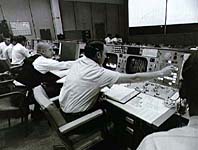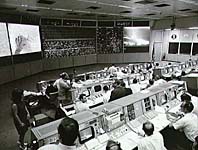From Sea to Shining Sea:
A Film Treatment by Paul Gasek and Gene Carl Feldman
15 JULY
Apollo 11
At Cape Kennedy, the 28 hour countdown to launch of the three man mission to the Moon begins. The eyes of the world are glued to the Cape, and the 363 foot tall Saturn rocket that will generate 7.6 million pounds of thrust and drive the three astronauts toward the Moon the next day. The names of Neil Armstrong and Buzz Aldrin are about to go down in history as the first to men to walk on the Moon.
PX-15
Jacques Piccard, Erwin Aebersold, Don Kazimir, Frank Busby, Ken Haigh, and Chet May will also go down in history as the first men to drift the Gulf Stream in a submersible - but almost no one will notice. Mission leader Piccard decides to get off the bottom. They "dribble shot" (jettison a carefully calculated weight of BB shot), ascend, and achieve neutral buoyancy at 300 meters or about 1000 feet down. With little or no fanfare, the 50 foot submersible Ben Franklin begins to drift northward in the core of the Gulf Stream at about 2 knots, or 2.4 miles an hour. The crew continues to calibrate instruments and get settled for the month ahead.
The Privateer drops a series of small depth charges into the sea overhead as Ken Haigh runs the first of many acoustic experiments using sound to compute water depth and sound-absorbing characteristics of the sea bottom.
16 JULY
Apollo 11
Mere hours away from lift-off, the Apollo crew receives a message from the Ben Franklin crew, submerged in 600 feet of water more or less directly offshore of Cape Kennedy: "From the crew of Ben Franklin to the crew of Apollo 11 - we all wish you fair wind and a following sea. Good luck!" There is no return message.

At 9:32 AM EST, Neil Armstrong, Buzz Aldrin, and Michael Collins blast off from Launch pad 39A. The whole world watches, electrified, as Walter Cronkite begins to report what President Nixon would eventually call "the greatest week in the history of the world since Creation." In the next eight days, the astronauts will attempt to walk on the Moon and come home safely. Just after noon EST, Apollo 11 slingshots out of Earth orbit toward the Moon, traveling at 24,200 miles an hour.
PX-15
Jacques Piccard says of the Ben Franklin’s Gulf Stream mission: "This voyage will loom almost as large in the history of oceanography as the lunar landing caused it to do in the annals of astronautics." The world isn’t listening. The Franklin settles into its scientific routine, now drifting at a little over 3 miles an hour.
While the astronauts travel in special, thermally controlled suits, the aquanauts have no such protection and suffer in the cool 56 degree temperatures at 800 to 1600 feet deep in the ocean. To conserve electricity, the sub uses no heaters. The entire crew catches a cold, and despite positive mental attitudes, struggles to work and stay warm through the entire 30 days. Humidity is 73% but will eventually go to 100%. The support ship Privateer takes up its station overhead and establishes phone communications with the Franklin.
17 JULY
Apollo 11
Mission Control gives the Apollo 11 crew a brief review of the news, including sports. At noon, the crew does a mid-course correction with a three second engine burn. At 7:30 PM EST, the first scheduled color views of Earth are transmitted from the command module at a distance of 128,000 nautical miles from that planet.

![]()

PX-15
After three days of shake-down, Piccard decides to extend the dive to the full 30 days, as the crew runs test after test to ensure the integrity of onboard systems. They prepare for decent to the bottom and a 24 hour cruise at a depth of 1800 feet. At that depth, the pressure on the Ben Franklin’s hull is a crushing 800 pounds per square inch, or 115,200 per square foot.
PREVIOUS PAGE | Page 8 | NEXT PAGE